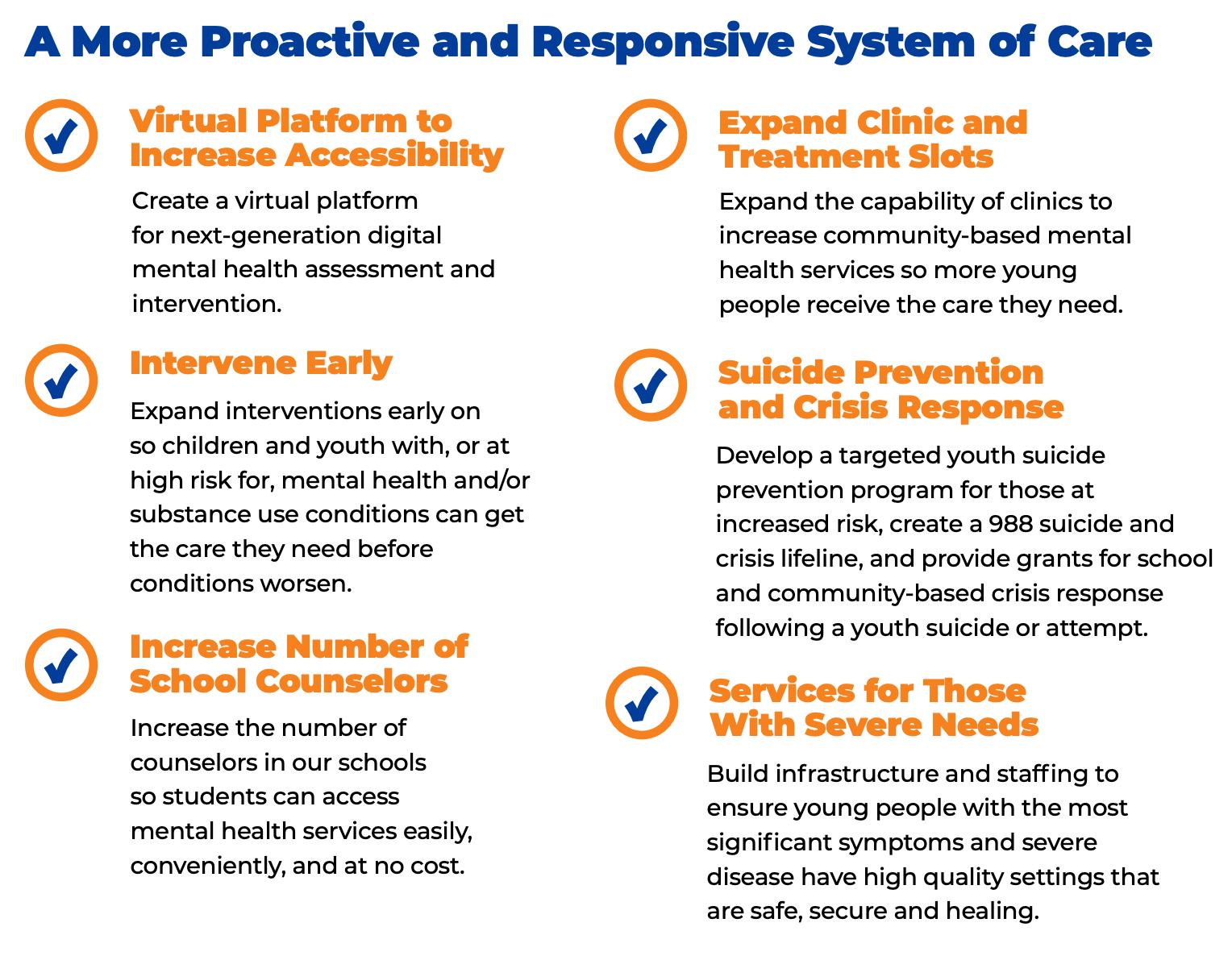Mental health for learning

Progress
Lots of things affect how well students do in school. Can they see what is written on the board at the front of the class? Can they hear questions the teacher is asking? Is hunger interfering with their ability to concentrate?

Shereen Walter is President of the California State PTA.
Since the pandemic, school communities are facing down a much broader health issue: mental health. It’s heartening and refreshing that discussions of mental health issues are no longer just whispered in private. School communities increasingly recognize that the social-emotional challenges children face must be addressed in order for them to learn.
Last year in California:
- More than 284,000 youth experienced a major depressive episode.
- Of those, 66% do not receive treatment.
- Suicide rates for kids ages 10-18 increased 20% between 2019-2020.
With this fresh clarity about the extent of the problems, Governor Newsom has made youth mental health a high priority. The state has committed $4.7 billion for a multi-year overhaul of California’s mental health system, including a master plan for kids mental health:

Other investments include:
- $4.1 billion on a community schools strategy to connect kids and families to essential services — including health screenings, meals and more.
- $5 billion on a Medi-Cal initiative, CalAIM, to better integrate health and behavioral health services for low-income kids.
- $1.4 billion to build the healthcare workforce that expands our capacity to meet the health needs of Californians, including children and families.
Parent advocacy in the legislature
PTA’s successful track record in speaking out for Mental Health Service for Our Children and Youth is one of the reasons I volunteer as President of the California State PTA. This past year, for example, PTA support helped another batch of important bills get through the legislature:
|
Mental health bills passed with PTA support this year |
|
|---|---|
|
Opioid overdose prevention and treatment: Melanie’s Law. |
Fentanyl is responsible for one in five youth deaths in California. SB 10 mandates that every public school in California provide training to school employees on opioid prevention and life-saving responses. |
|
Youth mental and behavioral health education. |
Requires the Department of Education to recommend best practices and identify training programs to help school districts address K-to 6 youth behavioral health. In grades 7 to 12, school districts have to certify that 40% of classified employees and 100% of certificated employees who directly serve those grades have youth behavioral health training. |
|
Body Shaming. |
Requires the Department of Education to create and post a model policy and resources on their website about body shaming and develop a model policy and resources about body shaming. |
|
Recess. |
Requires all public schools and charter schools to provide students with at least 30 minutes of recess on regular instructional days and at least 15 minutes on early release days. It also prohibits school staff members from restricting a pupil’s recess unless it poses an immediate threat to their safety or the safety of their peers. |
The link between parent and student mental health
A recent article from the Harvard Graduate School of Education, Caring for the Caregivers: The Critical Link Between Parent and Teen Mental Health, affirms what I have long suspected. There is a strong relationship between teen mental health and parent mental health. A major finding is that mental health programs and interventions treat teens in isolation, not in the context of their families.
The report identifies five strategies to support parents and help them prevent anxiety and depression in teens:
- Listen to adolescents.
- Help teens develop coping skills.
- Support the mental health of caregivers and families.
- Help parents talk about their own mental health challenges with children and teens.
- Help teens find purpose and meaning through service and community programs.
One strategy that schools and communities can adopt is to help teens find purpose and meaning through service and community programs. According to researchers, “caregivers should steer young people towards activities that provide purpose and offer a break from self-concerns.”
Resources to use at your school
Your school is the ideal place to provide mental health resources.
The Healthy Minds Toolkit from the National PTA gives you detailed guidance on how to connect families, students, and teachers to mental health resources. It includes:
- Guide: Understanding the Needs of Your School Community (en español)
- Tool: Healthy Minds School-Wide Needs Assessment Survey (en español)
- Tool: Healthy Minds PTA Discussion Guide (en español)
A resource for students is NAMI Ending the Silence, a free, evidence-based, 50-minute session designed for middle and high school students. Students will learn about mental health conditions through a brief presentation, short videos, and personal testimony from a young adult who describes their journey.
The California State PTA provides additional strategies.
PTA advocacy pays off
The table below lists PTA-supported mental health legislation that is now law.
|
PTA-supported mental health laws |
|
|---|---|
|
Excused Absences SB 14 (Portantino) |
Mandates that student absences for mental and behavioral health are treated the same as excused absences for physical health. |
|
Mental Health Education SB 244 (Portantino) |
Requires middle and high schools to include instruction in mental health if the schools offer courses in health education. |
|
Model Protocols AB 309 (Gabriel) |
Requires the California Department of Education to develop model referral protocols for addressing pupil mental health. |
|
The Safe and Supportive Schools Act |
The Safe and Supportive Schools Act requires online training for all certificated staff on cultural competency in supporting lesbian, gay, bisexual, transgender, queer, and questioning (LGBTQ+) students. |
|
Mental Health Resources |
Requires each school site serving pupils in grades 6 to 12 to create a poster that identifies approaches and shares resources regarding pupil mental health. |
|
Suicide Lifeline |
Creates 988 Suicide and Crisis Lifeline. |
|
Notice of Mental Health Services |
Requires a school or county office of education and a charter school to notify pupils and parents or guardians of pupils no less than twice during the school year on how to initiate access to available pupil mental health services on campus or in the community, or both. |
|
Mental Health Student ID Cards |
Public postsecondary education: mental health hotlines: student identification cards. |
|
Office of Suicide Prevention |
Establishes the Office of Suicide Prevention with emphasis the needs of youth and other vulnerable populations at risk of suicide. |
|
Suicide Lifeline on student ID cards |
Reguires a public school that serves 7th to 12th grade students and issues pupil identification cards to have the telephone number for the National Suicide Prevention Lifeline on the card and authorizes schools to also include the Crisis Text Line and a local suicide prevention hotline telephone number. |
|
Early Intervention |
Requires the Mental Health Services Oversight and Accountability Commission to establish priorities for the use of prevention and early intervention funds and to develop a statewide strategy for monitoring implementation of prevention and early intervention services |
|
Suicide Prevention Policies |
Requires a school board to review at minimum every 5th year, its policy on pupil suicide prevention and, if necessary, update its policy. |
Note: Carol Kocivar contributed to this post.
 Shereen Walter is President of the California State PTA. Shereen got involved in PTA for the same reason many parents do, to make a difference at her own child’s school. She has contributed her perspective on Ed100 many times over the years, including these related posts: Stress, anxiety and the start of school; Mental Health and Schools, and Suicide Prevention: The Role of Parents.
Shereen Walter is President of the California State PTA. Shereen got involved in PTA for the same reason many parents do, to make a difference at her own child’s school. She has contributed her perspective on Ed100 many times over the years, including these related posts: Stress, anxiety and the start of school; Mental Health and Schools, and Suicide Prevention: The Role of Parents.Tags on this post
PTA Mental HealthAll Tags
A-G requirements Absences Accountability Accreditation Achievement gap Administrators After school Algebra API Arts Assessment At-risk students Attendance Beacon links Bilingual education Bonds Brain Brown Act Budgets Bullying Burbank Business Career Carol Dweck Categorical funds Catholic schools Certification CHAMP Change Character Education Chart Charter schools Civics Class size CMOs Collective bargaining College Common core Community schools Contest Continuous Improvement Cost of education Counselors Creativity Crossword CSBA CTA Dashboard Data Dialogue District boundaries Districts Diversity Drawing DREAM Act Dyslexia EACH Early childhood Economic growth EdPrezi EdSource EdTech Education foundations Effort Election English learners Equity ESSA Ethnic studies Ethnic studies Evaluation rubric Expanded Learning Facilities Fake News Federal Federal policy Funding Gifted Graduation rates Grit Health Help Wanted History Home schools Homeless students Homework Hours of opportunity Humanities Independence Day Indignation Infrastructure Initiatives International Jargon Khan Academy Kindergarten LCAP LCFF Leaderboard Leadership Learning Litigation Lobbyists Local control Local funding Local governance Lottery Magnet schools Map Math Media Mental Health Mindfulness Mindset Myth Myths NAEP National comparisons NCLB Nutrition Pandemic Parcel taxes Parent Engagement Parent Leader Guide Parents peanut butter Pedagogy Pensions personalized Philanthropy PISA Planning Policy Politics population Poverty Preschool Prezi Private schools Prize Project-based learning Prop 13 Prop 98 Property taxes PTA Purpose of education puzzle Quality Race Rating Schools Reading Recruiting teachers Reform Religious education Religious schools Research Retaining teachers Rigor School board School choice School Climate School Closures Science Serrano vs Priest Sex Ed Site Map Sleep Social-emotional learning Song Special ed Spending SPSA Standards Strike STRS Student motivation Student voice Success Suicide Summer Superintendent Suspensions Talent Teacher pay Teacher shortage Teachers Technology Technology in education Template Test scores Tests Time in school Time on task Trump Undocumented Unions Universal education Vaccination Values Vaping Video Volunteering Volunteers Vote Vouchers Winners Year in ReviewSharing is caring!
Password Reset
Search all lesson and blog content here.
Login with Email
We will send your Login Link to your email
address. Click on the link and you will be
logged into Ed100. No more passwords to
remember!














Questions & Comments
To comment or reply, please sign in .